
Magic 101: How Creatures Die
Creatures die in Magic. A lot. Sometimes, however, there can be confusion as to when a creature is put into the graveyard, when it is exiled, what regeneration can do to prevent these terrible fates from befalling creatures, and so on. If these are some of the issues you have contemplated, then this article is for you.
How can creatures die?
First, something very basic. Each creature has a power and a toughness, and these two numbers are generally found in the lower right-hand corner of the creature card. The first number (the number on the left) is the creature's power (how much damage the creature deals in combat, among other things). The second number (the number on the right) is the creature's toughness, which generally indicates how much damage a creature can take before it dies.
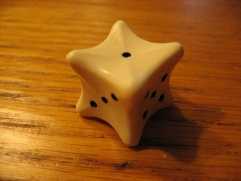
The only form of "die" found in
the Comprehensive Rules.
1. Traditional Destroy Effects
Someone casts Wrecking Ball targeting Squire, Wrecking Ball resolves, and Squire goes away. Easy. These cards specifically use the word "destroy," as opposed to "exile" or "return to hand" or something like that. "Destroy" has a very specific meaning within Magic; it is not interchangeable with any effect that causes a creature to leave the battlefield.
Not all "destroy" cards are created equal however. A card like Terminate also has an extra sentence specifying that a creature destroyed by it can't be regenerated. I'll talk about regeneration a little more later, but just be on the lookout for this. Also, some older cards, like the original Dark Banishing from Ice Age, used the term "bury" to mean "Destroy target
2. Lethal Damage
Another traditional way of killing a creature is lethal damage. Lethal damage is defined by the rules as "an amount of damage greater than or equal to a creature's toughness." Adding up all the damage a creature has taken over the entire turn, if a creature has been dealt lethal damage, it is destroyed. Note what I just said there: lethal damage is another way a creature is "destroyed" within the meaning of the rules. This is important because regeneration cares about this. Let's look at two short examples to examine the nuances of lethal damage.
Example #1: Adam controls Fire Elemental, a 5/4 creature. Barry casts Disfigure on the Fire Elemental, making it 3/2. Barry then casts Shock, targeting the Fire Elemental. The Fire Elemental has 2 toughness and 2 damage has been dealt to it this turn; it is destroyed.
Suppose Barry had cast Shock first, letting it deal its 2 damage to Fire Elemental, and then cast Disfigure. Would the Fire Elemental still die? Yes. The game sees that Fire Elemental has 2 toughness on it and has already been dealt 2 damage in the same turn. The Fire Elemental is destroyed and placed in the graveyard. It doesn't matter in which order the spells were cast.
Example #2: It is Adam's turn and he attacks with his Craw Wurm, a 6/4 creature, and Barry blocks with his Squire, a 1/2 creature. Craw Wurm deals 6 damage to Squire and Squire deals 1 damage to Craw Wurm. Squire is destroyed and Craw Wurm stays on the battlefield. Barry then casts Lightning Bolt, targeting the Craw Wurm. Lightning Bolt resolves, dealing 3 more damage to Craw Wurm. The game sees that Craw Wurm has been dealt 1 + 3 = 4 damage this turn, so Craw Wurm is destroyed.
But when does Craw Wurm die? Suppose Adam had Giant Growth and wanted to use it to save the Craw Wurm. What is the last moment he could cast Giant Growth and have Craw Wurm survive?
The game checking for lethal damage is something called a "state-based action" (formerly known as a "state-based effect" before the Magic 2010 rule changes). Every time a player is about to receive priority, the game says "Wait! I need to check for state-based actions first." (If you don't understand how priority works, I strongly recommend that you read my tutorial on Priority and the Stack before going any further, as you aren't going to understand a few other things I'm about to talk about).
So, going back to Example #2, if Adam wants his Craw Wurm to survive, the last chance Adam will have to save his Craw Wurm will be casting Giant Growth in response to Lightning Bolt (while Lightning Bolt is still on the stack). Once Lightning Bolt has resolved, it is too late for Adam to save Craw Wurm because while Adam would receive priority since a spell just resolved (the active player, the player whose turn it is, always receives priority after a spell resolves), the game says, "Hold on! Craw Wurm has lethal damage so I have to destroy it right this second; it's too late for you to do something to save him."
Note that damage is removed from creatures at the very end of each turn during the cleanup step; damage doesn't carry over from one turn to the next. It is usually not possible to do anything at this point in the turn after damage has been removed (there is a rare exception, but it's not terribly relevant here, so I won't get into it). Let's look at a few other ways to deal with creatures.
3. Zero or Less Toughness
A creature with toughness 0 or less is put into the graveyard as a state-based action. The creature is not destroyed; it's simply placed in the graveyard. This means a player can't use regeneration to save a creature with 0 toughness (again, I'll discuss regeneration in full down below). If Adam controls Squire and Barry casts Disfigure on it, Squire's toughness will be 0 and it will go to the graveyard.
Example #3: Adam controls Aura Shards and wants to get it to trigger so he can destroy Barry's Glorious Anthem. Unfortunately, the only creature Adam has in his hand is Skyshroud War Beast. Since Barry doesn't control any nonbasic lands, Skyshroud War Beast would be a 0/0 creature. Can Adam cast Skyshroud War Beast and get it to trigger Aura Shards?
Yes, he can. A creature that would enter the battlefield with 0 toughness still enters the battlefield; it just goes to the graveyard immediately. Aura Shards will see Skyshroud War Beast enter the battlefield, will trigger, and Adam can destroy Barry's Glorious Anthem.
4. The Legend Rule
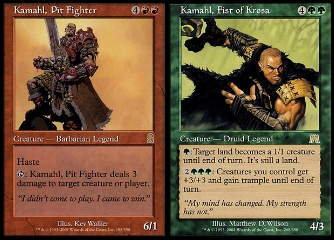
No problem here...
Example #4: Adam controls Kamahl, Pit Fighter and Gray Ogre, a 2/2 creature. Barry wants to cast his own Kamahl, Pit Fighter. Barry knows that if he casts his Kamahl, Adam's Kamahl will go to the graveyard along with Barry's Kamahl. However, Barry wants to try to use his Kamahl's activated ability (Kamahl has haste) to deal 3 damage to Adam's Gray Ogre before Barry's Kamahl is put in the graveyard. Can he do this?
No, because state-based actions can't be responded to at all. The game will immediately put both Kamahls in the graveyard after Barry's Kamahl resolves, preventing Barry from killing Adam's Gray Ogre.
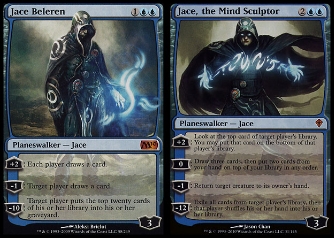
...but a big problem here.
5. Deathtouch
A creature that has been dealt damage by a source with deathtouch since the last time state-based actions were checked is destroyed the next time state-based actions are checked. This used to be a triggered ability where a player could respond to the deathtouch trigger with something like Regenerate, but that is no longer the case. This means that if a player wants to save his own creature in combat from another creature with deathtouch, the last chance to do something to interfere with that is during the declare blockers step.
Example #5: Adam controls Giant Scorpion enchanted with Sicken. Barry attacks with his Scaled Wurm. Can Adam block Barry's Scaled Wurm with his Giant Scorpion and destroy the Scaled Wurm?
No, because a creature with 0 power doesn't deal any combat damage. Even though Adam's Giant Scorpion has deathtouch, the deathtouch ability won't actually do anything unless Giant Scorpion actually deals damage. Scaled Wurm is free to run on over and try to smack Adam in the face without any fear of Giant Scorpion. However, if Adam were to cast Giant Growth on his Giant Scorpion before the combat damage step, Giant Scorpion would deal damage and would be able to destroy Scaled Wurm.
Example #6: Not having a Giant Growth in hand, Adam needs a way to deal with Barry's Scaled Wurm. Fortunately, he already has Cunning Sparkmage in hand and draws Basilisk Collar on his next turn. Adam casts Cunning Sparkmage, casts Basilisk Collar, and equips Basilisk Collar to Cunning Sparkmage. Adam activates Cunning Sparkmage's ability in order to deal 1 damage to Scaled Wurm. Will Scaled Wurm be destroyed?
Yes, because deathtouch doesn't require that the damage be combat damage. Instead, deathtouch works whenever any damage is dealt. Adam has quite a creature killer in his Cunning Sparkmage equipped with Basilisk Collar. As an aside, note that the other ability Basilisk Collar grants, lifelink, had its rules changed with the Magic 2010 rule changes also so that it is a static ability instead of a triggered ability, just like deathtouch.
6. Exiling
A creature that is exiled is put into the exiled zone. It is not destroyed, it's just put there. Other than that, exiling a creature is very similar to a traditional destroy effect like Wrecking Ball. Prior to the Magic 2010 rules changes, cards that exiled a creature caused the creature to be "removed from the game" instead. So, just know that old versions of Swords to Plowshares exile creatures just like Iona's Judgment does.
7. Sacrificing
A creature that is sacrificed, regardless of whether it is due to paying the activation cost of Altar of Dementia or as a result of a card like Diabolic Edict, is simply placed in the graveyard. It is not destroyed. Note that a creature that is sacrificed to something like Altar of Dementia to pay a cost is sacrificed when the spell is cast or the ability activated, not when it resolves. On the other hand, if the creature is sacrificed as a result of a spell or ability resolving, then obviously that creature is sacrificed upon resolution.
8. Bouncing
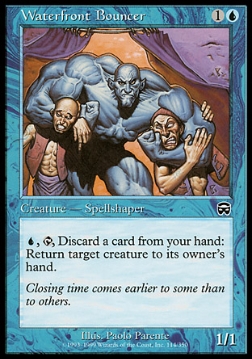
Example #7: Adam attacks with Tor Giant. Barry blocks with Border Guard, a 1/4 creature (Adam attacked because he was hoping that Barry would think that Adam had some kind of trick and therefore would not block). Adam's trick foiled, Tor Giant deals its 3 damage to Border Guard and Border Guard deals its 1 damage to Tor Giant. Adam casts Kor Skyfisher, which resolves. Kor Skyfisher's triggered ability resolves and Adam returns the Tor Giant that just attacked to his hand. Adam casts the same Tor Giant again and it resolves. Adam then casts Prosperity with X = 1. Adam draws something irrelevant while Barry draws Shock. Adam passes priority and Barry casts Shock, targeting the Tor Giant. Will the Tor Giant be destroyed?
No, it won't. Even though this exact same Tor Giant card was dealt 1 damage earlier in the turn, once it left the battlefield and returned, it is a new object and forgets what happened to it previously. Tor Giant is simply dealt 2 damage and sticks around because this Tor Giant hasn't been dealt any damage yet. Barry messed up on this one.
How can creatures avoid leaving the battlefield?
With all this talk about ways that creatures can die, perhaps it's time to discuss some key ways that creatures can avoid the trip to the graveyard. While there are of course many tricks to prevent a creature from being destroyed or preventing damage, the three most relevant topics are regeneration, indestructibility, and protection. However, before I get into that, it's important to make two lists: things that are destruction and things that are not destruction. I have split the traditional destroy effects into two categories: those that say that the thing being destroyed can't be regenerated and those that don't mention it (and therefore are implicitly ok with regeneration).
Things That Are Destruction
1. Traditional Destroy Effects – Can Be Regenerated
2. Traditional Destroy Effects – Can't Be Regenerated
3. Lethal Damage
4. Deathtouch
Things That Are Not Destruction
1. Zero or Less Toughness
2. The Legend Rule
3. Exiling
4. Sacrificing
5. "Bouncing" (returning a permanent to a player's hand and similar things)
1. Regeneration
Regeneration is all about timing. Some might think that paying for regeneration is done after a creature has been "destroyed" but before it is put in the graveyard, but this is not the case. Regeneration must be done before the creature is destroyed, otherwise it will be too late. The reason for this is that regenerating something sets up a replacement effect that says: "The next time this thing would be destroyed this turn, instead remove all damage from it and tap it (the tapping is not a cost; instead, the creature just becomes tapped if it is untapped). Additionally, if it's an attacking or blocking creature, remove it from combat." This is called creating a "regeneration shield." Multiple regeneration shields can be set up in a row to prevent multiple destructions during the same turn. Note that a regeneration shield doesn't do anything until the creature is actually about to be destroyed. In other words, activating the regeneration ability doesn't cause the creature to become tapped, leave combat, and so on; it is the destruction replacement that does this as it would actually be destroyed later on.
Honestly, I think regeneration ends up being more complicated than it should be not because regeneration itself is complicated, but because all of the things it does implicate a lot of different rules in a lot of different knowledge areas such that it can sometimes seem overwhelming. I'll try to break it down one piece at a time so it is all sorted out.
Let's get the basics down first.
Example #8: Adam controls an untapped River Boa (one of my favorite creatures). Barry has an untapped Fusion Elemental that he wants to attack with, but he is concerned that the River Boa will block it and regenerate, so he casts Shock, targeting the River Boa. In response, Adam activates River Boa's regeneration ability and it resolves, putting a regeneration shield on River Boa. Shock resolves and deals lethal damage to River Boa. The game sees that River Boa has lethal damage and tries to destroy it. The regeneration shield, however, instead says "no, we're going to regenerate it instead of destroying it." So, all the damage is removed from River Boa and River Boa becomes tapped. Barry is now free to attack with his Fusion Elemental without having to worry about it being blocked.
Example #9: Adam still has River Boa and an untapped Forest on the battlefield. Adam knows that Barry is holding Shock and he is worried that Barry will use it to try to destroy his River Boa. So, Adam says he is activating River Boa's regeneration ability. In response, Barry casts Shock, targeting River Boa. So the stack looks like this:
Top of Stack
Shock (targeting River Boa)
River Boa's Regeneration Ability
Bottom of Stack
Shock resolves first and destroys River Boa while the regeneration ability is still on the stack. River Boa is placed in the graveyard. River Boa's regeneration ability resolves, but it's too late; River Boa is already in the graveyard and there is no destruction to replace because the destruction has already happened. Adam's paranoia caused him to make a mistake here.
Example #10: Adam has an untapped River Boa and one untapped Forest. Barry controls Grizzly Bears and Tor Giant and has Shock in his hand. For whatever reason, Barry would like to ultimately destroy the River Boa, but he doesn't want to have to lose his Grizzly Bears in the process. So, Barry attacks with both Grizzly Bears and Tor Giant, hoping that Adam will block Tor Giant (in order to minimize attack damage) and then be regenerated. Adam, however, declares that he is blocking Grizzly Bears with River Boa. It is now the declare blockers step. Barry doesn't want to lose Grizzly Bears, so he casts Shock, targeting River Boa. Adam activates River Boa's regeneration ability in response and it resolves. Shock resolves and tries to destroy the River Boa. River Boa's regeneration shield kicks in, taps River Boa, and removes it from combat. The game moves to the combat damage step. Tor Giant, unblocked, deals 3 damage to Adam. Neither Grizzly Bears nor River Boa, however, will deal any damage. River Boa has been removed from combat, so it can't deal any combat damage. Grizzly Bears can't deal any damage to anything because it's already been blocked, but doesn't have any creatures blocking it remaining. This is just one of those weird quirks of the rules.
Example #11: Adam has an untapped River Boa and one untapped Forest and Barry has a Grizzly Bears and a Goblin Hero and does not control an Island (so, River Boa can't islandwalk over to Barry unblocked). Adam decides it is advantageous to attack with River Boa and does so. Barry blocks River Boa with both his Grizzly bears and his Goblin Hero. Adam activates River Boa's regeneration ability and it resolves. Will Adam's River Boa survive?
Yes, being dealt damage by multiple creatures at once only results in one destruction event, so one regeneration shield is enough here to save River Boa. Adam will be able to kill one of Barry's creatures with his River Boa's damage while saving his River Boa.
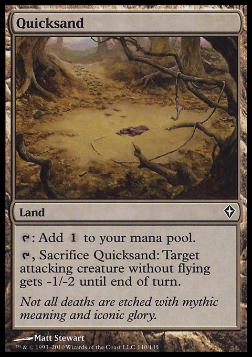
Quicksand, like Path to Exile, is also
an effective River Boa repellant.
River Boa is exiled and the regeneration shield does nothing. Because exiling is not destruction, regenerating River Boa can't save it in this situation.
So, how can you remember what is destruction and what is not? Well, it's really about just getting a familiarity with the rules and being able to recognize it. However, if that's initially too difficult (it took me a while to get all this straight), you can just use this chart:
Things That Allow for Regeneration
1. Traditional Destroy Effects – Can Be Regenerated
2. Lethal Damage
3. Deathtouch
Things That Don't Allow for Regeneration
1. Traditional Destroy Effects – Can't Be Regenerated
2. Zero or Less Toughness
3. The Legend Rule
4. Exiling
5. Sacrificing
6. "Bouncing" (returning a permanent to a player's hand and similar things)
Pretty simple, right? In fact, only three things in the whole game are destruction: destroy effects, lethal damage, and deathtouch. Everything else is not destruction so regeneration can't do anything about it.
2. Indestructibility
If something is indestructible, it simply can't be destroyed. So, destroy effects (whether they say anything about regeneration or not), lethal damage, and deathtouch don't destroy it. This doesn't cause the creature to become tapped, leave combat, or anything like that stuff involved with regeneration. Instead, the creature just isn't destroyed and goes on its merry way. Indestructible creatures can be dealt damage; it's just that lethal damage won't destroy the creature. This matters for creatures like Spiritmonger that trigger whenever they deal damage to a creature. Note, however, that being indestructible won't save a creature from things that don't try to "destroy" a creature; they are still completely vulnerable to these things. Consider the list again:
Things That Are Destruction
1. Traditional Destroy Effects – Can Be Regenerated
2. Traditional Destroy Effects – Can't Be Regenerated
3. Lethal Damage
4. Deathtouch
Things That Are Not Destruction
1. Zero or Less Toughness
2. The Legend Rule
3. Exiling
4. Sacrificing
5. "Bouncing" (returning a permanent to a player's hand and similar things)
Indestructible creatures are safe from things in the top list, but they are vulnerable to things in the bottom list.
Example #12: Adam controls Darksteel Gargoyle, an indestructible 3/3 creature. Barry casts Death Pulse, targeting the Darksteel Gargoyle. Even though the Darksteel Gargoyle is indestructible, it will be placed into the graveyard when Death Pulse resolves. A creature having 0 toughness is not "destroyed"; it's simply put in the graveyard.
3. Protection
Protection tutorials have probably been written by the dozens over the years, so I won't rehash protection in its entirety here (though if you are interested in reading a full protection FAQ, you can read one here by epeeguy). I will note, however, that protection from white (or whatever color) doesn't protect a creature from all things bad that are white. Instead, protection consists of a very precise set of qualities that are conferred upon a creature with protection. Let's consider two quick examples.
Example #13: Adam controls White Knight, a creature with protection from black. Barry casts Virtue's Ruin. Is Adam's White Knight destroyed by Virtue's Ruin?
Yes, because Virtue's Ruin is not one of the things that protection from black can save a creature from.
Example #14: Adam controls White Knight and Barry controls Giant Scorpion. Barry attacks with his Giant Scorpion and Adam blocks it with his White Knight. Will Adam's White Knight be destroyed by Giant Scorpion due to deathtouch?
No, because all the damage that Giant Scorpion would deal to White Knight is prevented by White Knight's protection from black. If the damage is never dealt, deathtouch never gets a chance to do its thing and White Knight can continue crusading across the countryside for all things good and lawful.
Do you think you have a handle on all of this? Let's find out with a brief quiz.
Problem #1: Adam attacks Barry with Centaur Courser and Barry blocks it with Merfolk Assassin. Barry then casts Electrostatic Bolt, targeting the Centaur Courser. What happens?
Centaur Courser will be destroyed. During the combat damage step, Centaur Courser will deal 3 damage to Merfolk Assassin (destroying it) and Merfolk Assassin will deal 1 damage to Centaur Course. Electrostatic Bolt dealing 2 more damage to Centaur Courser means that Centaur Courser will have been dealt 3 damage this turn, the game will see that Centaur Courser has lethal damage this turn (an amount of damage greater than or equal to the creature's toughness) and will destroy Centaur Courser.
Problem #2: Adam controls Snapping Creeper. Barry casts Firebolt, targeting the Snapping Creeper and it resolves. Barry then casts Devour in Shadow, targeting the Snapping Creeper. What happens?
Snapping Creeper will be destroyed and Barry will lose 3 life. This problem just makes sure that you understand that damage does not reduce a creature's toughness; it merely means that a creature has been damaged. The fact that the Snapping Creeper was damaged earlier in the turn does not affect Snapping Creeper's toughness nor how much life Barry will lose as a result of Devour in Shadow resolving.
Problem #3: Adam controls Walking Dead. Barry casts Last Gasp, targeting the Walking Dead. Adam activates Walking Dead's regenerate ability in response and it resolves. Last Gasp resolves. What happens?
Walking Dead is put into the graveyard as a state-based action. Regeneration cannot save a creature from having zero or less toughness because it is not destruction.
Problem #4: Adam controls Darksteel Gargoyle. Barry casts Afterlife, targeting the Darksteel Gargoyle. What happens?
Darksteel Gargoyle will remain on the battlefield and Adam will get a 1/1 white Spirit creature token with flying. A creature being indestructible doesn't prevent such a creature from being targeted with spells that try to destroy it nor does it mean that those spells will be countered on resolution. Instead, it just means the "destroy" part of the spell doesn't do anything. The fact that Afterlife specifies that the creature being destroyed can't be regenerated is irrelevant; indestructibility doesn't care about that. Since the spell isn't countered, Afterlife will do the rest of its thing, namely putting the 1/1 white Spirit creature token with flying onto the battlefield under Adam's control. Not exactly a great move by Barry here.
Problem #5: Adam controls Pillarfield Ox and Vedalken Orrery. Barry attacks with Grizzly Bears and Adam blocks it with the Pillarfield Ox. The game moves to the combat damage step, damage is dealt (destroying the Grizzly Bears) and Adam casts Flicker, targeting his Pillarfield Ox, which resolves. The game moves to Barry's second main phase and Barry casts Firebolt, targeting the Pillarfield Ox. What happens?
Adam's Pillarfield Ox survives. When a creature leaves the battlefield and returns, it enters the battlefield as a new object and "forgets" its old existence. As far as the game is concerned, this Pillarfield Ox has only been dealt 2 damage this turn and should stay on the battlefield.
Problem #6: Adam controls Black Knight. Barry casts Wrath of God. What happens?
Black Knight is destroyed. This is the classic example of how protection works with a global destroy effect. Wrath of God doesn't target, so protection won't do anything to save the Black Knight here.
Problem #7: Adam controls Eater of Days. Barry casts Vindicate, targeting the Eater of Days, which resolves. Adam then casts Death Ward. What happens?
Adam can't cast Death Ward to save Eater of Days because it is too late; Eater of Days is already in the graveyard (so technically the game will have to back up and Adam won't be allowed to cast Death Ward at all). Adam has to cast Death Ward in response to Vindicate if he wants to save Eater of Days. Death Ward would save Eater of Days because Vindicate doesn't say anything about the target not being able to be regenerated. Also note that if Adam plays it right so that he regenerates Eater of Days, he won't skip his next two turns. Regeneration doesn't cause a creature to leave the battlefield and then return; instead, the creature just stays on the battlefield, all damage is removed, and the creature becomes tapped.
Problem #8: Adam controls Uthden Troll, declares he is attacking Barry with it, and taps it. During the declare blockers step, Barry casts Lightning Bolt targeting the Uthden Troll. Adam attempts to regenerate Uthden Troll in response. What happens?
Uthden Troll will be regenerated, but it will be removed from combat as a result and won't deal any combat damage. The fact that Uthden Troll is tapped doesn't prevent it from regenerating. Instead, whenever a creature regenerates, it becomes tapped if it isn't already tapped.
That wraps up another edition of Magic 101. I hope you found it informative. If you have a comment, question, snide remark, or suggestion for a future article, please post or send me a private message. Thanks for reading!
-
View User Profile
-
Send Message
Posted Jun 8, 2016-
View User Profile
-
Send Message
Posted Jun 13, 2016A more complicated subtle issue is why Draco benefits from Inner-Flame Acolyte's ability. The short answer is that Cauldron Dance resolves all at once before any triggered abilities go on the stack or targets are chosen (like Inner-Flame Acolyte's comes-onto-the-battlefield ability). Hence, Draco will be on the battlefield in time to be chosen as a target for Inner-Flame Acolyte's triggered ability.
(Also, note that this article was written before the term "die" was added to the comprehensive rules; the caption for the first image in the article is now out of date!)
-
View User Profile
-
Send Message
Posted Apr 13, 2015-
View User Profile
-
Send Message
Posted Apr 14, 2015702.2b Any nonzero amount of combat damage assigned to a creature by a source with deathtouch is considered to be lethal damage, regardless of that creature’s toughness.
-
View User Profile
-
Send Message
Posted Apr 15, 2015-
View User Profile
-
Send Message
Posted Apr 17, 2015They're pretty dense though---not for the faint of heart!
-
View User Profile
-
Send Message
Posted Apr 19, 2015